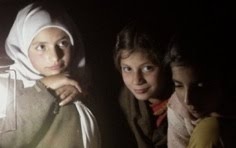 The storyworld knows that our real power lies within. The storyworld knows too, that we often need some person, some creature or even some thing to help us bridge the not-knowing and the knowing of this truth. And to this end, as the writer Hannah Arendt so beautifully put it: “Storytelling reveals meaning without committing the error of defining it.”
The storyworld knows that our real power lies within. The storyworld knows too, that we often need some person, some creature or even some thing to help us bridge the not-knowing and the knowing of this truth. And to this end, as the writer Hannah Arendt so beautifully put it: “Storytelling reveals meaning without committing the error of defining it.”A businessman approached the Wise One. “All my decisions seem wrong, I never make enough money … you must help me. You are known for your wisdom; advise me about what to do differently.”
The Wise One simply gave him a tiny locked treasure chest charm, and said, “Take this with you everywhere, and shake it three times whenever you enter a new space or meet someone for the first time.” Somewhat skeptical, he looked at the tiny charm. “Oh well,” he thought, ”Maybe there is an exotic magic object inside which will bring me luck; no harm in trying it out.”
He carried the little charm everywhere, and in the space that he shook it thrice, waited, and paid attention, he noticed an opportunity here, a danger or pitfall there. A year went by and his luck had totally changed.
He went back to the Wise One and excitedly asked for the key. At first she refused, but he persisted, and she reluctantly opened the tiny little treasure chest. The man reached out and almost snatched it from her. He looked inside - there was no magical object within.
“Why … there’s nothing inside!” he exclaimed in shock.
“But there is on the outside,” she smiled.
The power of talismans to open us to our own capacities needs to be better understood, and this lesson is best communicated through Story, as in this beautiful Traditional one -- but modern tales too have had much the same point to make to a rather different audience, as in the story of Dumbo, the Flying Elephant.
Born into a circus, a baby elephant is rejected by the others because of his unusually big ears. Jeered at by children, rejected by the other performers, poor Dumbo is demoted to appearing as a clumsy, bumbling creature in an act with the clowns.
Only the little Timothy Q. Mouse befriends him, and devises a plan to make lonely little Dumbo a star. He gets a crafty crow to inform Dumbo that magic flying feathers are what really make crows able to fly, and if Dumbo had just one such magic feather, then he would be able to fly too. Plucking a feather out of a friend's tail and giving it to Dumbo, he says, "This is a magic flying feather for you." And wonder of wonders - Dumbo flies on his first try, and because of this, is made part of a more daring performance, where he has to leap from a high platform as part of the clown’s Fire Rescue act.
All goes well till one day, about to dive off the high platform in the middle of the act, Dumbo somehow loses the magic feather. Timothy Mouse, terrified, immediately yells and convinces him, "It isn’t really magic. You can fly on your own." And Dumbo, flapping his enormous ears madly, discovers in that moment that it was not the feather at all which had the power of flight, but Dumbo himself.
The feather was only a bridge to put him in touch with a gift that was his all along.
In our lives, we are in need of magic feathers in the form of talismans or beliefs that can help us reach new heights. Our lesson is to utilize them for as long as we need them, but recognizing them for the temporary gift they are, we are challenged transcend the need for an outer reminder of what has been ours all along.
May your magic feather help you discover the magic within.
Marguerite Theophil
More than true
Fairy tales are more than true:
not because they tell us that dragons exist,
but because they tell us that dragons can be beaten.
~ G. K. Chesterton









